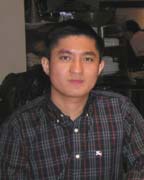Lehigh group reports best threshold values for near-infrared range InGaAsN lasers

The ink was hardly dry on his new contract as assistant professor of electrical and computer engineering at Lehigh, when Nelson Tansu announced a breakthrough in his research into high-performance lasers.
In two recent issues of Applied Physics Letters (APL) – on July 7 and Sept. 29, Tansu and other collaborating researchers reported the best threshold values to date for near-infrared-range (with an emission wavelength of 1300-nm), indium-gallium-arsenide-nitride (InGaAsN) lasers emitting from a quantum well.
Tansu’s group also achieved the best threshold values yet for near-infrared-range quantum-well (QW) lasers operating under continuous-wave conditions at temperatures up to 100 degrees C.
The work of Tansu’s group was featured in the September issue of LaserFocusWorld, a photonics and optoelectronics industry journal.
One month later, on Oct. 10, Tansu was featured in the cover article of GATRA, the second-most widely circulated weekly news magazine in Indonesia (population 250 million), where Tansu was born and raised. The article described five Indonesians who are employed as university professors outside Indonesia.
The first APL article, titled “High-performance and high-temperature continuous-wave-operation 1300-nm InGaAsN quantum well lasers by organometallic vapor phase epitaxy,” is one of eleven journal and conference papers Tansu has published since joining the Lehigh faculty.
The other articles have appeared in several APLs, IEEE’s Journal of Quantum Electronics, IEEE’s Journal of Selected Topics in Quantum Electronics, the Proceedings of the 16th IEEE Laser and Electro Optics Society Annual Meeting (2003), and other journals and conference proceedings. Tansu has also been invited to write a review paper on the physics and devices of dilute nitride lasers for an issue of the IOP’s Journal of Physics: Condensed Matter Physics in 2004.
The general goal of Tansu’s work is to use metal organic chemical vapor deposition (MOCVD) to develop lasers and advanced compound semiconductor nanostructures for optoelectronic devices. His research interests are also related to combining these semiconductor nanostructures with photonic crystals (artificial structures with periodicity of certain optical properties), to realize novel optoelectronic devices. His work has applications in optical communications, mid-infrared devices, free-space communications, visible light sources, information sciences, and biochemical detection.
Tansu says the criteria for high-performance lasers include low operating current, high efficiency, the ability to operate at high speeds at a range of temperatures (from room temperature to 100 degrees C.), and the ability to operate at high temperatures without the need for costly additional electronics to maintain thermal stability.
One type of laser with which Tansu works is high-performance VCSELs, or vertical cavity surface-emitting lasers, which are cheap to produce and operate at a low current. VCSELs are used in short-haul communications systems, which operate with an 850-nm wavelength, allow a transmission range of about 200-500 meters and are typically used in university campuses, offices, residential complexes, and similar venues.
The accomplishments by Tansu’s group have the potential to lead to the realization of low-cost and high-performance 1300-nm VCSELs, capable of a transmission rate of 10 gigabytes per second. Tansu’s group is one of the first to realize high-performance near-infrared range InGaAsN quantum wells by using MOCVD technology, which is the technology of choice to realize VCSELs in manufacturing. Near-infrared range lasers, which operate with a 1300-nm wavelength, allow a transmission range of 20 to 100 kilometers and are also called metropolitan optical networks because they can connect cities that are in close proximity.
The group achieved its breakthrough using InGaAsN, a new lasing material also known as dilute-nitride, on a gallium-arsenide substrate, instead of the conventional approach based on indium-phosphide technology.
“Using dilute-nitride grown on a gallium-arsenide base,” says Tansu, “it is much easier to make the high-performance reflectors that are critical to achieving high-performance VCSELs. We accomplished this by using MOCVD, which is also known as MOVPE [Metal-Organic Vapor Phase Epitaxy].”
Tansu’s works represent the first realization of MOCVD-grown high-performance 1300-nm dilute-nitride lasers under continuous-wave (CW) operations rather than pulsed conditions, and with a better performance than that achieved with molecular beam epitaxy. (A German research group previously demonstrated that type of high-performance laser with molecular beam epitaxy.) CW is a virtual prerequisite for lasers to be used in real-world applications; pulsed conditions are typically used in the early stages of experimentation.
The lasers in Tansu’s system emit from a 6-nm-thick quantum well that is grown on a dilute-nitride semiconductor nanostructure layer using a strained-compensated technique.
Tansu earned his bachelor’s and Ph.D. degrees in 1998 and 2003, respectively, from the University of Wisconsin-Madison, where he also won the 2003 Harold A. Peterson Best Research Paper Award.
Media Contact
More Information:
http://www3.lehigh.edu/engineering/news/tansuvaluesforinfraredrange.aspAll latest news from the category: Physics and Astronomy
This area deals with the fundamental laws and building blocks of nature and how they interact, the properties and the behavior of matter, and research into space and time and their structures.
innovations-report provides in-depth reports and articles on subjects such as astrophysics, laser technologies, nuclear, quantum, particle and solid-state physics, nanotechnologies, planetary research and findings (Mars, Venus) and developments related to the Hubble Telescope.
Newest articles

Superradiant atoms could push the boundaries of how precisely time can be measured
Superradiant atoms can help us measure time more precisely than ever. In a new study, researchers from the University of Copenhagen present a new method for measuring the time interval,…

Ion thermoelectric conversion devices for near room temperature
The electrode sheet of the thermoelectric device consists of ionic hydrogel, which is sandwiched between the electrodes to form, and the Prussian blue on the electrode undergoes a redox reaction…

Zap Energy achieves 37-million-degree temperatures in a compact device
New publication reports record electron temperatures for a small-scale, sheared-flow-stabilized Z-pinch fusion device. In the nine decades since humans first produced fusion reactions, only a few fusion technologies have demonstrated…





















